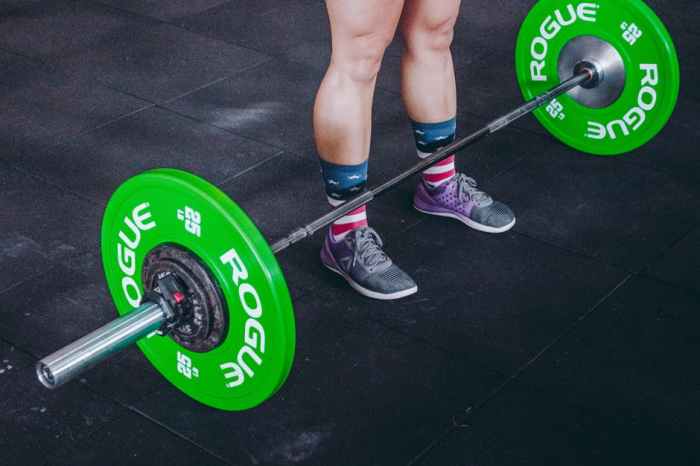Strength training for weight loss is more than just building muscle; it’s a powerful pathway to a healthier, more vibrant you. This comprehensive guide delves into the science behind how strength training boosts your metabolism and calorie expenditure, leading to sustainable weight loss. We’ll explore various effective exercises, from compound movements to isolation work, tailored for different fitness levels.
Learn how to design a personalized program, incorporate proper nutrition and recovery strategies, and monitor your progress effectively.
From building a structured workout routine to understanding the crucial role of nutrition and recovery, this guide empowers you to achieve your weight loss goals with strength training. We’ll equip you with the knowledge and practical strategies to transform your body and mindset through the transformative power of strength training. Discover the best exercises, meal plans, and techniques to optimize your results and experience sustainable weight loss.
Introduction to Strength Training for Weight Loss
Strength training is a powerful tool for weight loss that goes beyond just burning calories during the workout. It significantly impacts your body’s metabolism and hormonal balance, leading to a more efficient calorie-burning machine even when you’re at rest. This article delves into the physiological mechanisms behind strength training’s effectiveness and explores different types of exercises for maximizing weight loss results.Strength training, when integrated into a comprehensive weight loss plan, plays a crucial role in improving body composition.
It builds muscle mass, which in turn boosts your resting metabolic rate. A higher resting metabolic rate means your body burns more calories throughout the day, even when you’re not actively exercising. This sustained calorie expenditure is key to achieving and maintaining a healthy weight.
Physiological Mechanisms of Strength Training for Weight Loss
Strength training’s impact on metabolism stems from the body’s need to repair and rebuild muscle tissue after exercise. This process requires energy, driving up your metabolic rate. The increase in muscle mass directly correlates with a higher resting metabolic rate. Furthermore, strength training promotes the release of hormones like growth hormone and testosterone, which can also contribute to fat burning and overall well-being.
The body’s increased demand for energy is crucial for weight management.
Types of Strength Training Exercises for Weight Loss
A variety of exercises can be effective for weight loss, ranging from traditional weightlifting to bodyweight exercises and circuit training. Each approach has its own unique benefits and can be tailored to different fitness levels. The key is to choose exercises that challenge your muscles and promote adaptation.
Effectiveness Comparison of Strength Training Approaches
| Training Approach | Effectiveness for Weight Loss | Advantages | Disadvantages |
|---|---|---|---|
| Resistance Training (Weightlifting) | High | Builds significant muscle mass, boosts metabolism dramatically, and provides a strong foundation for overall fitness. | Requires access to equipment, can be more challenging for beginners to learn proper form, and takes time to master. |
| Bodyweight Exercises | Moderate to High | Requires no equipment, easily adaptable to various fitness levels, and can be done anywhere. | May not provide the same level of muscle hypertrophy as weightlifting, and can be challenging to progress as strength increases. |
| Circuit Training | High | Combines cardio and strength training for a time-efficient workout, excellent for burning calories and building endurance. | May not be ideal for individuals focusing solely on muscle hypertrophy, and requires a well-structured routine for optimal results. |
This table summarizes the effectiveness, advantages, and disadvantages of different strength training approaches for weight loss. Choosing the right approach depends on individual preferences, access to resources, and fitness goals. For instance, individuals new to strength training might find bodyweight exercises a more accessible starting point. Conversely, those seeking substantial muscle gain and enhanced metabolism might find weightlifting more effective.
Strength training is a fantastic way to boost your metabolism and shed those extra pounds. However, if you’re dealing with arthritis on one side of your body, arthritis on one side of the body can make certain exercises challenging. Modifying your routine to focus on low-impact exercises and pain-free movements is key, and this often requires careful consideration.
Luckily, there are plenty of strength training options that are both effective and safe for individuals with this condition. Finding a qualified professional can help you tailor your routine.
Ultimately, the most effective approach is one that is sustainable and enjoyable for the individual.
Building a Strength Training Program for Weight Loss

Strength training is a powerful tool for weight loss, but it’s not a magic bullet. To maximize its effectiveness, it must be integrated with a healthy diet and a well-structured program. This approach goes beyond just lifting weights; it’s about building a sustainable lifestyle that combines physical activity with mindful eating. Understanding the principles of progressive overload, proper warm-up and cool-down, and a balanced workout schedule is crucial for achieving lasting results.Strength training, when combined with a balanced diet, significantly improves weight loss outcomes.
The increase in muscle mass boosts metabolism, leading to a higher calorie burn even at rest. A balanced diet, emphasizing whole foods, lean proteins, and complex carbohydrates, provides the necessary nutrients for muscle growth and repair, ensuring the body has the fuel it needs for optimal performance.
Balanced Diet and Strength Training
A balanced diet is essential for supporting strength training and achieving weight loss goals. Proper nutrition fuels muscle growth, recovery, and overall well-being. A diet rich in lean proteins, complex carbohydrates, and healthy fats provides the necessary energy for workouts and supports muscle repair and growth. Crucially, the diet must align with caloric needs for weight loss.
Progressive Overload in Strength Training
Progressive overload is a fundamental principle in strength training. It involves gradually increasing the demands placed on the muscles over time. This could be through increasing weight, repetitions, sets, or the frequency of workouts. This gradual increase in stress on the muscles stimulates them to adapt and grow stronger. Without progressive overload, the body adapts to the current level of stress, and no further gains are achieved.
This is crucial for consistent progress and avoiding plateaus.
Strength training is awesome for shedding those extra pounds, but did you know it can also indirectly boost your hair health? Pairing strength training with a healthy diet and, say, incorporating chia seed oil for hair growth into your routine could be a game-changer. Chia seed oil for hair growth might seem like a strange addition, but it’s a great way to support overall health, which in turn can help you reach your strength training weight loss goals.
Ultimately, focusing on a well-rounded approach to health, including regular exercise, is key to lasting results.
Sample Strength Training Program
This sample program focuses on compound exercises, which work multiple muscle groups simultaneously, maximizing calorie burn and building overall strength. It incorporates progressive overload principles.
- Warm-up (5-10 minutes): Dynamic stretches like arm circles, leg swings, and torso twists to prepare the body for exercise.
- Workout (30-45 minutes):
- Squats: 3 sets of 8-12 repetitions.
- Deadlifts: 1 set of 5 repetitions.
- Bench Press: 3 sets of 8-12 repetitions.
- Overhead Press: 3 sets of 8-12 repetitions.
- Rows: 3 sets of 8-12 repetitions.
- Cool-down (5-10 minutes): Static stretches, holding each stretch for 20-30 seconds, to promote flexibility and reduce muscle soreness.
Warm-up and Cool-down Routines
Proper warm-up and cool-down routines are vital for injury prevention and optimal performance. A warm-up prepares the muscles for the workout by increasing blood flow and body temperature. Cool-down stretches improve flexibility, reduce muscle soreness, and aid in recovery.
Workout Schedules
Different workout schedules cater to various lifestyles and fitness levels. Consistency is key, so choosing a schedule that fits into your routine and that you can maintain long-term is crucial.
| Workout Schedule | Frequency | Description |
|---|---|---|
| 3 days a week | 3 sessions per week, allowing for rest days | Suitable for beginners or those with busy schedules. Focus on proper form and gradually increasing intensity. |
| 4 days a week | 4 sessions per week, with rest days in between | Provides more training volume, leading to faster progress for intermediate lifters. |
| 5 days a week | 5 sessions per week, with rest days in between | Ideal for advanced trainees or those aiming for maximum muscle growth and strength gains. |
Exercise Selection and Form for Weight Loss
Choosing the right exercises and mastering proper form is crucial for effective weight loss and building strength. A well-designed program combines compound movements to maximize calorie burn and muscle engagement, alongside isolation exercises to target specific muscle groups for balanced development. Understanding and consistently practicing correct form is paramount to achieving results safely and preventing injuries. Modifications tailored to individual fitness levels ensure that everyone can participate and progress effectively.
Compound Exercises for Weight Loss
Compound exercises work multiple muscle groups simultaneously, leading to greater calorie expenditure and overall strength gains. These movements are essential for building a strong foundation for weight loss and overall fitness. Prioritizing compound exercises in your routine ensures a more efficient and effective workout.
- Squats: This exercise targets the quads, hamstrings, glutes, and core. Proper form involves maintaining a straight back, engaging your core, and keeping your knees aligned with your toes. Variations include goblet squats, front squats, and Bulgarian split squats, each offering different levels of intensity and challenge.
- Deadlifts: A powerful compound exercise that works the entire posterior chain, including the back, hamstrings, and glutes. Form is critical; maintain a neutral spine, keep the back straight, and hinge at the hips. Variations like Romanian deadlifts and conventional deadlifts offer different focuses and intensity levels.
- Bench Press: A cornerstone exercise targeting the chest, shoulders, and triceps. Correct form involves maintaining a controlled descent and upward push, keeping the back flat against the bench and avoiding arching. Variations include incline and decline bench presses to target specific areas of the chest.
- Overhead Press: This exercise engages the shoulders, triceps, and upper back. Maintaining proper form involves a controlled lift, ensuring a stable posture, and avoiding jerking movements. Variations include military press and Arnold press, which offer different challenges and approaches.
- Rows: These exercises target the back muscles, including the lats, rhomboids, and traps. Maintain a straight back and pull the weight towards your chest, keeping the elbows close to your body. Variations include barbell rows, dumbbell rows, and cable rows, offering different levels of resistance and intensity.
Isolation Exercises for Targeted Muscle Development
Isolation exercises target specific muscle groups, allowing for focused development and definition. Incorporating these exercises into your routine helps create a balanced physique.
- Bicep Curls: This exercise isolates the biceps, developing their size and strength. Using dumbbells or barbells, focus on controlled movements, ensuring the biceps are the primary movers. Variations include hammer curls and concentration curls.
- Triceps Extensions: Targeting the triceps, these exercises promote strength and definition. Variations include overhead extensions, skullcrushers, and close-grip bench press.
- Lateral Raises: Working the side deltoids (shoulders), these exercises build shoulder width and strength. Proper form involves controlled movements, avoiding jerky motions.
- Leg Extensions: Targeting the quadriceps, these exercises enhance leg strength and definition. Controlled movements and proper form are crucial to avoid injury.
- Hamstring Curls: Targeting the hamstrings, these exercises build leg strength and definition. Proper form involves controlled movements, keeping the focus on the hamstrings.
Importance of Proper Exercise Form
Maintaining proper exercise form is paramount to maximizing results and minimizing injury risk. Consistent attention to detail during each repetition is vital for long-term fitness success.
Proper form prevents injuries and maximizes muscle engagement.
Modifying Exercises for Different Fitness Levels, Strength training for weight loss
Modifying exercises caters to various fitness levels and allows individuals to gradually progress. Adjusting weights, resistance, or the number of repetitions ensures a safe and effective workout.
- Beginner Modifications: Beginners may start with lighter weights or resistance bands. Reducing the number of repetitions or sets is also a viable option.
- Intermediate Modifications: As fitness levels improve, gradually increase the weight or resistance. Incrementally increasing the number of repetitions or sets can also help in increasing intensity.
- Advanced Modifications: Advanced individuals can incorporate variations of exercises, such as using different equipment or changing the tempo.
Common Strength Training Exercises and Targeted Muscle Groups
| Exercise | Primary Muscle Groups Targeted |
|---|---|
| Squats | Quads, hamstrings, glutes, core |
| Deadlifts | Back, hamstrings, glutes |
| Bench Press | Chest, shoulders, triceps |
| Overhead Press | Shoulders, triceps, upper back |
| Rows | Back, biceps, forearms |
| Bicep Curls | Biceps |
| Triceps Extensions | Triceps |
| Lateral Raises | Shoulders |
| Leg Extensions | Quads |
| Hamstring Curls | Hamstrings |
Nutrition and Recovery for Weight Loss: Strength Training For Weight Loss
Fueling your strength training journey is just as crucial as the workouts themselves. Proper nutrition and recovery strategies are essential for maximizing muscle growth, minimizing muscle soreness, and supporting overall health. Ignoring these elements can hinder progress and even lead to injury. This section delves into the vital role of nutrition and recovery in your weight loss goals.Understanding how your body utilizes nutrients during and after exercise is key to achieving optimal results.
Strength training is a fantastic way to boost your metabolism and shed those extra pounds. But, to really maximize weight loss, you also need to consider the role of cardiovascular exercise, like the important connection between cardiovascular exercise and diabetes. Cardiovascular exercise and diabetes are intrinsically linked, and incorporating both types of exercise into a well-rounded routine can be highly beneficial for overall health.
Ultimately, combining strength training with a strategic approach to cardiovascular exercise will significantly improve your weight loss journey.
By focusing on protein intake, calorie balance, and key recovery elements, you’ll enhance your workouts and support your body’s natural processes for building muscle and shedding fat.
Protein Intake for Muscle Growth and Recovery
Protein is the building block of muscle tissue. Adequate protein intake is critical for supporting muscle growth and repair after strength training sessions. When you lift weights, you create microscopic tears in your muscle fibers. Protein provides the essential amino acids needed to rebuild and strengthen these fibers, leading to increased muscle mass. This process is called muscle protein synthesis.A general recommendation is to consume 1.2 to 1.8 grams of protein per kilogram of body weight per day.
This can vary depending on individual factors such as activity levels, training intensity, and overall health. Include lean protein sources in your diet such as poultry, fish, eggs, beans, lentils, and tofu.
Importance of Calorie Intake
Calorie intake plays a critical role in supporting muscle repair and overall energy levels. Your body needs sufficient calories to fuel your workouts and to support the energy-intensive process of muscle repair. If you consume too few calories, your body may start breaking down muscle tissue for energy, hindering your progress. This is often referred to as a catabolic state.
Conversely, consuming too many calories can lead to fat storage. Striking a balance is key.A registered dietitian or a certified personal trainer can help you determine your individual calorie needs based on factors such as age, activity level, and weight loss goals. Maintaining a consistent calorie intake that supports your workouts while being in a calorie deficit for weight loss is essential for optimal results.
Dietary Strategies for Weight Loss
Various dietary strategies can support weight loss alongside strength training. High-protein diets, for example, often promote satiety and can help preserve muscle mass during weight loss. A balanced diet that includes lean proteins, complex carbohydrates, and healthy fats provides a comprehensive array of nutrients to support energy levels and overall health.A balanced approach that incorporates lean protein, fruits, vegetables, whole grains, and healthy fats can provide the necessary nutrients while controlling calorie intake.
Ultimately, the most effective approach is one that aligns with your individual needs and preferences, is sustainable, and allows you to maintain a healthy lifestyle.
Sleep and Hydration for Optimal Recovery
Sufficient sleep and hydration are paramount for muscle recovery and overall health. During sleep, your body repairs and rebuilds tissues, including muscle tissue. Aim for 7-9 hours of quality sleep each night. Dehydration can impair performance and hinder recovery. Drink plenty of water throughout the day, especially before, during, and after workouts.Hydration is crucial for transporting nutrients to muscles, regulating body temperature, and supporting overall bodily functions.
Dehydration can lead to fatigue, reduced performance, and impaired recovery. Consuming adequate fluids before, during, and after workouts is essential for maintaining optimal performance and recovery.
Healthy Meal Options for Strength Training and Weight Loss
| Meal | Protein Source | Carbohydrate Source | Healthy Fat Source | Example |
|---|---|---|---|---|
| Breakfast | Greek Yogurt | Oatmeal | Nuts | Greek yogurt with berries, oatmeal, and almonds |
| Lunch | Chicken Breast | Brown Rice | Avocado | Grilled chicken breast with brown rice and avocado |
| Dinner | Salmon | Sweet Potatoes | Olive Oil | Baked salmon with sweet potatoes and olive oil |
| Pre-Workout Snack | Protein Shake | Fruit | – | Protein shake with banana |
| Post-Workout Snack | Whey Protein | Whole-grain bread | – | Whey protein shake with whole-grain bread |
These are just a few examples, and you can adapt these to your liking. Remember to adjust portion sizes to align with your individual calorie needs and weight loss goals. Consult a registered dietitian or a nutritionist for personalized advice.
Monitoring Progress and Adaptation

Staying motivated and seeing results are crucial for any fitness journey, especially when aiming for weight loss through strength training. Monitoring your progress is not just about tracking numbers; it’s about understanding how your body adapts to the program and making necessary adjustments to keep moving forward. Consistent progress, whether small or large, is key to long-term success.Understanding how your body responds to the training program is essential for continued progress.
Adapting the plan allows you to continually challenge your muscles and optimize results. Regular evaluation of your progress helps to ensure that you’re pushing yourself effectively and not plateaued. Adjustments to your training and nutrition plan can prevent stagnation and keep you on track toward your goals.
Tracking Progress in Strength Training
Regular tracking of key metrics allows for objective assessment of progress. Monitoring weight lifted, repetitions, and sets provides concrete data to evaluate improvement over time. This data is vital for understanding how your body is adapting to the training stimulus. Accurate tracking helps to determine if adjustments are necessary to prevent plateaus and maintain motivation.
Adjusting the Strength Training Program
As your fitness level improves, the strength training program needs to evolve. Modifying the program is critical to continue challenging your muscles and avoid plateaus. Increasing the weight, reps, or sets, or altering the exercises, are all important strategies to continue seeing progress. Progressive overload, the gradual increase in training demands, is crucial for continued muscle growth and strength gains.
Examples of Program Modifications
When you consistently lift the same weight and complete the same number of reps and sets, you may experience a plateau. To avoid this, gradually increase the weight lifted, increase the number of reps or sets, or change the exercises. If you notice you can consistently complete more reps with the current weight, it’s time to increase the weight to maintain the challenge.
Alternatively, if you’re struggling to complete the required reps or sets, you might need to reduce the weight or modify the exercise to a simpler variation.
Staying Motivated
Maintaining motivation throughout the weight loss journey is essential for long-term success. Celebrating milestones, no matter how small, can significantly boost morale. Tracking progress visually, like through before-and-after photos, can be a powerful motivator. Finding a workout buddy or joining a fitness community can also provide support and encouragement.
Strategies for Motivation
Setting realistic goals and breaking them down into smaller, achievable steps can make the journey less daunting. Visualizing your desired outcome and the benefits of reaching your goals can increase motivation. Remember that progress takes time and consistency.
Progress Tracking Methods
| Method | Description | Example |
|---|---|---|
| Before/After Photos | Visual representation of physical changes over time. | Taking photos from the same angle, same lighting, and similar clothing to accurately compare changes in body composition. |
| Weight Measurements | Tracking changes in body weight over time. | Weighing yourself at the same time each day, preferably after using the restroom and before eating. |
| Body Composition Analysis | Measuring body fat percentage, muscle mass, and other components of body composition. | Utilizing tools like DEXA scans, Bod Pod, or other body composition analyzers. |
| Training Log | Recording workout details including weight, reps, sets, and exercises. | Creating a dedicated log to document each training session and track progress. |
Common Mistakes and Considerations
Strength training for weight loss is a powerful tool, but it’s crucial to understand potential pitfalls and strategies for success. This section dives into common mistakes, the importance of recovery, maintaining consistency, overcoming plateaus, and crucial safety precautions. Understanding these factors will help you optimize your training and achieve your goals.Proper execution and attention to detail are key to maximizing the benefits of strength training.
Ignoring these aspects can lead to frustration and setbacks, preventing you from achieving your desired results.
Common Mistakes in Strength Training for Weight Loss
Understanding common mistakes can help you avoid them and maximize your results. Incorrect form, inadequate rest, and inconsistent routines are some of the most frequent errors. Poor form can lead to injuries, while inadequate rest hinders progress and increases the risk of burnout. Inconsistency makes it difficult to see progress and can lead to discouragement.
- Ignoring Proper Form: Incorrect form during exercises can lead to injuries and hinder progress. Focus on controlled movements and proper alignment to maximize effectiveness and minimize risk. A professional trainer can provide valuable guidance and demonstrate proper technique. For example, improper bench press form can strain the shoulders and back, negating the intended benefits.
- Insufficient Rest and Recovery: Muscle growth and repair occur during rest, not during exercise. Adequate rest allows your body to recover from workouts, reducing the risk of injuries and promoting optimal muscle growth. Insufficient rest can lead to fatigue, overtraining, and reduced performance.
- Lack of Consistency: Regularity is key to achieving results. Skipping workouts or inconsistent routines hinder progress. Develop a sustainable workout schedule and stick to it as much as possible. Consistency promotes adaptation and builds a foundation for long-term results.
Importance of Rest and Recovery
Rest is not a passive element; it’s an active component of your strength training program. Adequate rest allows your muscles to repair and rebuild, leading to increased strength and reduced risk of injury. It also allows your body to recover from the stress of exercise.
- Muscle Repair and Growth: Muscles grow and repair during rest, not during exercise. Rest periods allow protein synthesis to occur, which is essential for muscle growth and repair.
- Reduced Risk of Injury: Insufficient rest increases the risk of injuries, including strains and tears. Allowing your body to recover properly reduces the likelihood of these issues.
- Improved Performance: Adequate rest leads to improved performance during subsequent workouts. Your body is better prepared to handle the demands of exercise, leading to better results.
Overcoming Plateaus in Strength Training and Weight Loss
Plateaus are a common experience in strength training and weight loss. They occur when progress slows or stops. Understanding the reasons for plateaus and adjusting your approach can help you overcome them.
- Adjusting Training Volume and Intensity: Increasing the weight, reps, or sets can break through plateaus. Adjusting the intensity of your workouts can help stimulate muscle growth. Gradually increasing the load, sets, and reps will help overcome plateaus.
- Modifying Exercise Selection: Changing exercises can help target different muscle groups or introduce new challenges. This keeps your body from adapting to the same exercises, promoting progress. For example, switching from barbell squats to goblet squats can provide a different stimulus.
- Evaluating Nutrition and Recovery Practices: Assess your diet and recovery routines to identify areas for improvement. Ensure you are consuming enough protein and calories to support your training needs. Adequate sleep and hydration are also essential.
Safety Precautions in Strength Training for Weight Loss
Safety is paramount in strength training. Following proper precautions can prevent injuries and ensure a safe and effective workout.
- Warm-up and Cool-down: Always warm up before each workout and cool down afterward. This prepares your muscles for the workout and helps prevent injuries. A warm-up increases blood flow to the muscles, preparing them for the stress of exercise.
- Proper Form and Technique: Focus on maintaining proper form and technique throughout each exercise. This reduces the risk of injury and maximizes the effectiveness of the workout. Consult a professional if needed.
- Listen to Your Body: Pay attention to any pain or discomfort during your workout. If you experience pain, stop the exercise and rest. Don’t push through pain; it could lead to serious injury.
Common Mistakes and How to Avoid Them
| Common Mistake | How to Avoid It |
|---|---|
| Ignoring proper form | Seek professional guidance, watch instructional videos, and practice proper technique consistently. |
| Insufficient rest | Schedule adequate rest days, prioritize sleep, and incorporate active recovery techniques. |
| Lack of consistency | Create a sustainable workout schedule and stick to it, utilizing workout tracking apps if needed. |
Advanced Strategies for Weight Loss
Taking your strength training for weight loss to the next level requires advanced techniques that push your body’s limits and maximize fat burning. These strategies, when combined with a solid foundation of proper form, nutrition, and recovery, can significantly accelerate your progress. Beyond the basics, we’ll explore how to optimize your workouts for maximum fat loss.Advanced techniques like supersets and drop sets can help you burn more calories and build lean muscle more effectively.
By combining exercises and challenging your muscles in different ways, you can achieve faster results. Understanding how different training programs affect fat burning is also crucial for tailoring your workouts to your specific goals.
Supersets and Drop Sets for Faster Results
Supersets and drop sets are advanced training techniques that involve performing two exercises back-to-back with minimal rest. This method increases the intensity of your workout, elevates your heart rate, and stimulates muscle growth. Drop sets involve progressively reducing the weight as you perform sets of an exercise. This technique is beneficial for maximizing muscle fatigue and pushing your body to its limits.
- Supersets: Performing two exercises sequentially with little to no rest between them targets multiple muscle groups and elevates your heart rate, increasing calorie expenditure. Examples include alternating bench press and overhead press, or squats and lunges.
- Drop Sets: Gradually decreasing the weight during a set maximizes muscle fatigue and promotes greater muscle growth. An example would be performing a set of bicep curls with 20lbs, then immediately dropping to 15lbs for another set, and then again to 10lbs for a final set.
Different Strength Training Programs for Fat Burning
Various strength training programs cater to different fitness levels and goals. A program focusing on compound exercises, like squats, deadlifts, and bench presses, is highly effective for fat burning. These exercises engage multiple muscle groups, leading to a greater calorie expenditure and increased metabolic rate. Programs incorporating variations in intensity and volume, such as high-volume or circuit training, can also enhance fat burning.
- High-Intensity Interval Training (HIIT) with Strength Training: Incorporating short bursts of intense strength training with brief recovery periods can boost calorie burn and increase metabolism.
- Full-Body Workouts: Focusing on compound exercises that work multiple muscle groups at once, like squats, deadlifts, and bench presses, maximizes calorie expenditure and fat burning.
Incorporating Cardio with Strength Training
Integrating cardio into your strength training routine can further optimize fat burning. Combining cardio exercises, such as running or cycling, with strength training sessions can maximize calorie expenditure and improve cardiovascular health. Consider incorporating short bursts of high-intensity cardio between sets of strength training exercises.
- Circuit Training: Combining strength training exercises with cardio intervals, like jumping jacks or burpees, in a circuit format can effectively elevate your heart rate and burn calories.
- Cardio after Strength Training: Including cardio after a strength training session can help burn additional calories and further enhance fat loss. However, this depends on your individual needs and goals.
Managing Stress and Its Impact on Weight Loss
Stress can significantly impact weight loss efforts. Elevated stress hormones, such as cortisol, can lead to increased appetite and decreased metabolism. Incorporating stress-management techniques, like meditation or yoga, can help regulate cortisol levels and support weight loss goals.
- Stress Reduction Techniques: Practices like meditation, deep breathing exercises, or yoga can help regulate stress hormones and improve overall well-being, indirectly supporting weight loss efforts.
- Prioritizing Sleep: Adequate sleep is crucial for managing stress and maintaining a healthy metabolism, both vital for effective weight loss.
Advanced Training Techniques Comparison
| Technique | Description | Benefits |
|---|---|---|
| Supersets | Two exercises performed back-to-back with minimal rest. | Increased intensity, elevated heart rate, multiple muscle group engagement. |
| Drop Sets | Progressive reduction in weight during a set. | Maximizes muscle fatigue, promotes muscle growth. |
| HIIT with Strength Training | Short bursts of intense strength training with brief recovery periods. | Increased calorie burn, elevated metabolism. |
| Full-Body Workouts | Compound exercises working multiple muscle groups simultaneously. | Maximize calorie expenditure, increase metabolic rate. |
Final Thoughts
In conclusion, strength training for weight loss is a journey of self-discovery and transformation. By understanding the physiological mechanisms, building a personalized program, and focusing on nutrition and recovery, you can effectively achieve sustainable weight loss and build a stronger, healthier you. Remember to prioritize consistency, listen to your body, and adapt your plan as needed. This guide provides a solid foundation; now it’s time to put in the effort and see the results!










